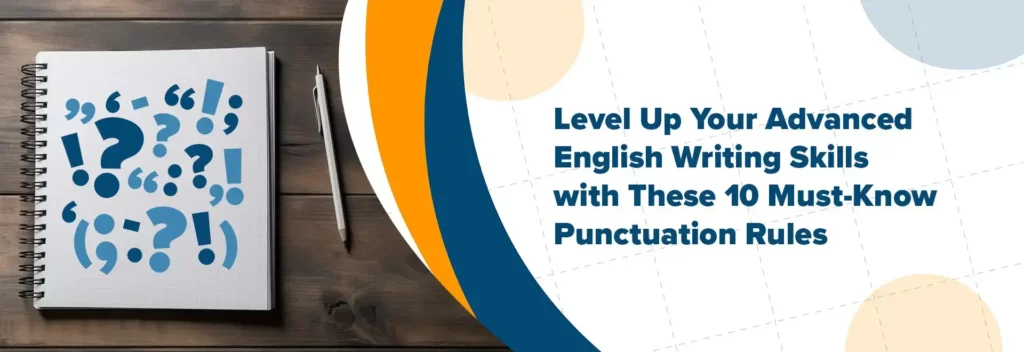
Level Up Your Advanced English Writing Skills with These 10 Must-Know Punctuation Rules
Punctuation is a fundamental aspect of the English language that significantly impacts the clarity and effectiveness of your writing. Punctuation is often overlooked in the realm of advanced English skills. However, mastering punctuation is crucial for effective communication and conveying the intended meaning.
Punctuation is used to clarify information and the meaning of a piece of writing. It is essential that you are knowledgeable about punctuation rules, especially when you are writing. Whether it is a short sentence, a paragraph, an essay, or a simple email, it is important that you know the rules and the correct punctuation marks to use to provide clarity of meaning and emphasize the tone of your writing piece.
The Importance of Punctuation in English Writing
In writing, aside from capitalization, punctuation is one of the most important aspects that makes a written piece meaningful and comprehensible. Without punctuation, the meaning of a text may be vague as there are some statements that may have a positive connotation, but the reader may perceive them as negative.
How important is punctuation in writing?
Punctuation, often taken for granted in the world of written communication, is the unsung hero of effective English writing. It may seem like a minor detail, but punctuation marks are the signposts and traffic signals of written language, guiding readers through the intricacies of sentences, clarifying meaning, and infusing tone and emphasis into the written word.
In this part of the article, we’ll delve into the pivotal role of punctuation in English writing and explore how it shapes the way we communicate.
- Clarifying Sentence Structure
At its core, punctuation is a tool for structuring sentences. Without it, written language would resemble a labyrinth of words with no clear pathways. Consider the period, which denotes the end of a sentence, the comma that separates items in a list, and the semicolon that bridges related independent clauses. These punctuation marks provide an essential framework for constructing coherent and comprehensible sentences.
- Conveying Tone and Emphasis
Punctuation allows writers to infuse their sentences with tone and emotion. The exclamation point adds excitement or urgency, while the question mark signals curiosity or uncertainty. Ellipses create an air of suspense or contemplation. Careful selection and placement of these marks can transform a sentence’s meaning and impact.
- Quoting and Dialogue
Quotation marks serve a crucial role in indicating direct speech and setting off quoted material, such as book titles or song lyrics. They distinguish between a writer’s voice and that of another, ensuring proper attribution and clarity in attribution.
- Enhancing Readability
A well-placed comma can make the difference between a sentence’s clear meaning and a confusing jumble of words. Parentheses enclose supplementary information, ensuring it doesn’t disrupt the sentence’s flow but remains accessible to the reader. Brackets provide a means for editors or writers to add clarifications to quoted text without altering the original source.
- List Separation
Lists, whether in a grocery store or a scholarly paper, rely on punctuation for clarity. The comma separates items in a list, making it evident where one item ends and the next begins. The semicolon can be used to separate items in a list when those items contain internal commas, avoiding confusion.
- Showing Omission
Apostrophes indicate possession and contraction. In contractions like “can’t” (for “cannot”) or “I’m” (for “I am”), the apostrophe replaces omitted letters. In possessives, such as “John’s book,” it clarifies that the book belongs to John.
- Abbreviations
Punctuation often plays a role in abbreviations, such as “Dr.” for “Doctor” or “etc.” for “et cetera.” These marks not only save space but also convey specific meanings.
- Legal and Technical Writing
In legal and technical documents, precise punctuation usage is paramount. Misplaced or omitted punctuation can lead to confusion or alter the interpretation of contracts, regulations, or scientific papers.
- Avoiding Ambiguity
Clear and proper punctuation can eliminate ambiguity and ensure that readers interpret sentences as intended. A misplaced comma can dramatically change the meaning of a sentence, and omitting a question mark can turn a question into a statement.
Mastery of punctuation is, therefore, essential for effective communication and ensuring that your written words resonate with clarity, precision, and impact. So, the next time you encounter a comma or a semicolon, remember that it’s not just a mark on a page; it’s a vital component of the art of effective English writing.

Advanced English Punctuation Rules in Writing
In essence, punctuation in English writing is not a collection of arbitrary rules but a powerful system for conveying meaning, tone, and structure. It is the invisible hand that shapes words into coherent thoughts and guides readers through the intricacies of written language.
To enhance your advanced English skills and elevate your writing to the next level, it is crucial to grasp these ten essential punctuation rules. By mastering these rules, you will be able to convey your thoughts with precision and elegance. Let’s check them out below!
The Comma [,]
The comma, known as the workhorse of punctuation, plays a crucial role in creating clarity and proper sentence structure. Use a comma to separate items in a list, combine independent clauses, set off introductory phrases, and indicate pauses in a sentence. Proper comma usage ensures that your writing flows smoothly and effectively.
Commas are also used to separate coordinate adjectives and before conjunctions like “and,” “but,” or “so” when they connect two independent clauses. So, whether you’re listing, joining, or introducing, remember to utilize the trusty comma.
Examples:
I bought apples, oranges, and bananas from the grocery store.
After finishing my dinner, I went for a walk in the park.
She was tired, yet she managed to complete her assignment.
Remember to use a comma to emphasize and clarify the meaning of the statement. Look at the following examples:
“Let’s eat Ben.” – this example seems to be perilous because the one who listens may conclude that the speaker wants to eat Ben.
“Let’s eat, Ben.” – this example means that the speaker invites Ben to eat.
The Semi-colon [;]
The semicolon is a powerful punctuation mark that exists somewhere between a comma and a period. Use the semicolon to connect closely related ideas without breaking the flow of a sentence. By mastering the semicolon, you can showcase your advanced English skills and add sophistication to your writing.
The semi-colon is often misunderstood but it is an effective tool that can enhance the flow and coherence of your writing. It is primarily used to connect closely related independent clauses without the use of a coordinating conjunction. Additionally, semi-colons can be used to join items in a list that already contain commas.
Examples:
John is studying medicine; his dream is to become a doctor.
The trip will take us to Paris, France; Rome, Italy; and Athens, Greece.
The Colon [:]
The colon is often misunderstood but serves an essential purpose in creating emphasis and providing additional information. It can introduce lists, explanations, examples, or quotes. By incorporating colons effectively, you can add a touch of authority and clarity to your writing, making your points stand out.
Use a colon to draw attention to the words, phrases, or expressions that follow it.
Examples:
My daily routine includes the following: eating, working, attending meetings, and sleeping.
I think I am guilty of doing unacceptable things: being greedy and being too jealous
The Dash [—]
Dashes are an often-overlooked punctuation mark, but they can add zest and drama to your writing. Whether you choose to use an en dash or an em dash, they can be used to emphasize a point, set off a parenthetical phrase, or create a dramatic pause. By utilizing dashes appropriately, you can engage your readers and make your writing more captivating.
Dashes, both en dashes (–) and em dashes (—), are versatile punctuation marks that can add emphasis or provide interruption in a sentence. They can be used to set off additional information, create a dramatic effect, or indicate an abrupt change of thought. If you know how to use dashes in your writing, your advanced English skills are amazing.
Examples:
The building—old, weathered, and abandoned—stood as a reminder of the past.
I can’t believe she said that—it was completely unexpected!
Quotation Marks [” “]
Quotation marks are not just for dialogue. Use quotation marks to incorporate direct quotations and titles into short pieces of work. They also play a vital role in indicating titles, sarcasm, or irony. Understanding the various uses of quotation marks can enhance your advanced English skills and ensure that your intended meaning is accurately conveyed.
Examples:
I really like the movie “3 Idiots” because we can learn a lot of morals from it.
“The youth are the hope of the fatherland.” – Dr. Jose P. Rizal
The Apostrophe [‘]
Use the apostrophe for these two primary purposes: indicating possession and forming contractions in the English language. It shows ownership of something or signifies the omission of letters to form contractions.
Examples:
Sarah’s book (indicating the book belongs to Sarah)
It’s raining outside. (contraction of “it is”)
Mastering the correct usage of apostrophes is essential for demonstrating your advanced English skills while avoiding common grammatical errors. So, whether it’s expressing ownership or contracting words, use the apostrophe with confidence and precision.
The Hyphen [-]
Hyphens may seem insignificant, but they play a crucial role in joining words and creating compound adjectives. Hyphens are punctuation marks used to connect words or parts of words to create compound words, join prefixes and suffixes, numbers and fractions, and clarify the meaning of sentences. They play a vital role in improving readability and comprehension in written language.
Examples:
Sister-in-law
Well-prepared guests
Co-worker
Re-encode
Forty-one
One-third
By understanding when to use hyphens, you can convey your ideas more clearly and avoid ambiguity. So, whether it’s a well-thought-out plan or a state-of-the-art technology, remember to utilize the hyphen appropriately.
The Exclamation Mark [!]
Exclamation marks are powerful punctuation marks used to convey strong emotions or exclamatory statements. They are used in emphatic statements, commands, and interjections. However, they should be used sparingly and appropriately to maintain impact. By using exclamation marks effectively, you can infuse your writing with energy and excitement.
Examples:
We must win this game! (emphatic)
Take out the trash now! (command)
Oh my God! (interjection)
The Parentheses [( )]
Parentheses are often used to add additional information or clarify a point without disrupting the flow of the main sentence. By mastering the art of using parentheses, you can provide context and depth to your writing while maintaining a smooth reading experience for your audience.
Parentheses, also known as round brackets, are punctuation marks used to set off or enclose supplementary or explanatory information within a sentence as well as in introducing an acronym. They are also used in citations and references. Parentheses are advanced English punctuation marks that are helpful in providing accurate information to your readers.
Examples:
The school intramurals (which lasted three days) was a great success. – Additional information
The World Health Organization (WHO) found out the root cause of the viral outbreak. – acronym
(Doe, 2023) argues that… – citation
The Ellipsis […]
Ellipses, which consist of three evenly spaced dots ( . . . ), are punctuation marks used to indicate the omission of words or phrases from a quoted passage, to create a pause or trailing-off effect in writing, or to convey uncertainty or suspense.
The ellipsis is a punctuation mark that signifies trailing off, hesitation, or creating suspense. By incorporating ellipses strategically, you can add intrigue to your writing and keep your readers engaged. So, whether you want to create a sense of mystery or unfinished thought, the ellipsis is your go-to punctuation mark.
Examples:
Original: “The journey of a thousand miles begins with a single step.”
Quoted with an ellipsis: “The journey . . . begins with a single step.”
“I wonder if…?”

Conclusion
Mastering punctuation rules is crucial for enhancing your advanced English skills and ensuring clear and effective communication. By becoming familiar with the comma, semicolon, colon, dash, quotation marks, apostrophe, hyphen, exclamation mark, parentheses, and ellipsis, you can elevate your writing to a new level.
These punctuation rules will improve your advanced English writing skills significantly. Practice incorporating these rules into your writing, and soon you will notice a remarkable improvement in your ability to communicate effectively and eloquently.
Remember, the key to mastery is practice. Consistently applying these punctuation rules will undoubtedly elevate your writing to new heights. Start implementing them today and watch your advanced English skills soar!



